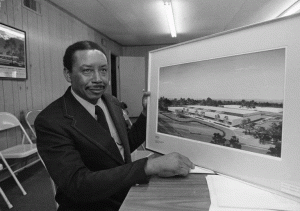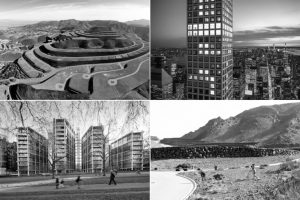Two reissued classics of New Deal literature, “Black Metropolis” and “Modern Housing,” deserve new attention from architects and urbanists.
Sometime in mid-June 2020, as protesters across the United States dethroned monuments to white supremacy, the sculptures adorning the grounds of New York’s Rockefeller Center were fitted with blue surgical masks. Among them was the figure of Prometheus, gilded and unbound, as portrayed in 1934 by the sculptor Paul Manship. Despite the mask, it is not difficult to recognize the whiteness of Manship’s Prometheus, a characteristic that is confirmed when we learn that the model who sat for the figure was Leonardo Nole, a lifeguard from New Rochelle, New York, whose Italian-American heritage had only recently joined the ranks of racial privilege. 1 The Prometheus myth, in which the Titan who defied Zeus by delivering fire to humankind is forever bound in punishment, is also in no small degree the myth of the modern architect and of modern planning. In Delirious New York, Rem Koolhaas rewrote that myth by casting Rockefeller Center’s commercial architects as capitalist heroes: Wallace Harrison as Howard Roark.
 Many scholars, educators, and students concerned with racial and economic justice are now ferociously debating the content of syllabi on which books like Delirious New York and other period apologias like Learning from Las Vegas (by Robert Venturi, Denise Scott Brown, and Steven Izenour) have long been fixtures. These titles may well remain unchallenged, not least for their genuine insight but also as units of ideological currency that still underwrite professional careers. To some readers, such books may seem mere curiosities, momentary and even enjoyable distractions from more serious matters, rather than the durably hegemonic depictions of architecture and the American city that they are.
Many scholars, educators, and students concerned with racial and economic justice are now ferociously debating the content of syllabi on which books like Delirious New York and other period apologias like Learning from Las Vegas (by Robert Venturi, Denise Scott Brown, and Steven Izenour) have long been fixtures. These titles may well remain unchallenged, not least for their genuine insight but also as units of ideological currency that still underwrite professional careers. To some readers, such books may seem mere curiosities, momentary and even enjoyable distractions from more serious matters, rather than the durably hegemonic depictions of architecture and the American city that they are.
When you have shot one bird flying you have shot all birds flying. They are all different and they fly in different ways but the sensation is the same and the last one is as good as the first. Duis aute irure dolor in reprehenderit in voluptate velit esse cillum dolore eu fugiat nulla pariatur. Excepteur sint occaecat cupidatat non proident, sunt in culpa.
For example: When read across the grain of its 1930s setting, Delirious New York is an unapologetic rebuke — the creative, life-affirming struggle of real estate development against the chains of government regulation — to the New Deal public planning that, for all its racial exclusions, sought to dampen what John Maynard Keynes called capitalism’s “animal spirits.” Between its lines, Koolhaas’s book also represents an unsubtle repudiation of the European welfare state and its architects, including the author’s immediate Dutch predecessors, and of the earnest provision of housing and other public goods for what that earlier generation called the “greater number.” To seal the deal, the book’s message of rebirth, composed in New York during the 1970s, awkwardly ignores the racial strife that had been roiling American cities for the past century. Despite its manifest irony, Delirious New York deserves our renewed scrutiny today because it is actively not about public planning, social housing, or Black life. Full of energy, the technological triumph of big business for which Rockefeller Center stands is precisely what racial capitalism looks like, with or without a mask.

The same Promethean fire that powers the great skyscraper machine also forged the chains that have long bound the Titan’s subordinated human kin laboring in the machine’s guts. Among these chains at Rockefeller Center is the system of cables and pulleys that guided the dozens of elevators and their operators shuttling office workers up and down the vertical monoliths — the RCA Building and its companions — from which the complex was assembled. Students of architecture will remember such elevators as the internal dynamos propelling what Koolhaas called “Manhattanism.” Careful readers might also recognize in them a symbolic redemption — via the white-collar “culture of congestion” — of the high-rise building and its technologies, which had in those years been charged with architecture’s version of a crime against humanity — with the broken-down skip-stop elevators of the racially segregated, underfunded Pruitt-Igoe public housing complex in St. Louis as Exhibit A.

Today, the New Deal era in which Rockefeller Center rose has acquired new relevance to anyone concerned with recovery from crisis, even as Delirious New York begins to show its neoliberal age. To those in architecture or urbanism who are thinking, then, about what to read or what to teach instead, two recently republished New Deal classics stand out. These are Modern Housing, by Catherine Bauer, from 1934, reissued this year by the University of Minnesota Press with a new foreword by Barbara Penner; and Black Metropolis: A Study of Negro Life in a Northern City, by St. Clair Drake and Horace R. Cayton, from 1945, reissued in 2015 by the University of Chicago Press with a new foreword by Mary Pattillo. 2 With students’ reading time more limited than ever, it would be naïve simply to add these two volumes to existing lists. It would also be downright disingenuous to pretend that their measured anti-capitalism can (or should) be offset — just to be fair — with a dash of Koolhaasian Kool-Aid. Given the take-no-prisoners posture of the latter, no symmetrical, pedagogical balance can be achieved here. As a thought experiment, then, I suggest an asymmetrical agon: readers and teachers must prioritize one or the other. If the combined 1,357 social-scientific pages of the two reprints are weighed against the 263 heavily illustrated, telegraphic pages of witty retro-manifesto, the outcome may seem predictable enough.


